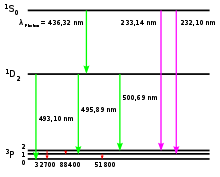Doubly ionized oxygen

In astronomy and atomic physics, doubly ionized oxygen (also known as O III) is the ion O2+. Its emission forbidden lines in the visible spectrum, primarily at the wavelength 500.7 nm, and secondarily at 495.9 nm, are known in astronomical spectroscopy as [O III]. Before spectra of oxygen ions became known, these lines once led to a spurious identification of the substance as a new chemical element. Concentrated levels of O III are found in diffuse and planetary nebulae. Consequently, narrow band-pass filters that isolate the 501 nm and 496 nm wavelengths of light, that correspond to green-turquoise-cyan spectral colors, are useful in observing these objects, causing them to appear at higher contrast against the filtered and consequently blacker background of space (and possibly light-polluted terrestrial atmosphere) where the frequencies of [O III] are much less pronounced.
These emission lines were first discovered in the spectra of planetary nebulae in the 1860s. At that time, they were thought to be due to a new element which was named nebulium. In 1927, Ira Sprague Bowen came up with the current explanation of them being due to doubly ionized oxygen.[1]
Permitted lines of O III lie in the Middle Ultraviolet band and are hence inaccessible to terrestrial astronomy.
See also
References
- ↑ Bowen, I. S. (1927). "The Origin of the Nebulium Spectrum". Nature. 120 (3022): 473. Bibcode:1927Natur.120..473B. doi:10.1038/120473a0.